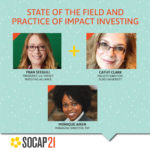
Why are you participating in SOCAP/Europe?
Design that Matters’ (DtM’s) uses design to benefit poor communities in the developing world. SOCAP11 will help us scale our design services for the social sector while also scaling multiple, specific design solutions including our Firefly infant phototherapy device, Lynx low-cost pediatric hearing aid, and Kinkajou classroom microfilm projector. SOCAP presents an opportunity to meet potential donors to fund the further production of Firefly and Kinkajou, partners whose communities could benefit from new or existing designs, and collaborators that can make valuable contributions to the DtM team.
What problem are you addressing? Why should people care?
By World Bank estimates, two-thirds of the world population lives on less than $2 per day. These communities lack access to such basic necessities as clean water, affordable health care and basic education. They lack stable housing and employment opportunities. In many cases, they are not participants in the cash economy. Social enterprises focusing on solutions for poor communities in the developing world face a lack of financing, business services, and other forms of intellectual capital including access to affordable design services.Design that Matters provides design capabilities through innovative and flexible partnerships with social enterprises allowingthem to offer better products and services to their communities and scale more quickly.
What are the main roadblocks keeping you from your goals?
With two products implemented in West Africa and India, and a third on is way to Vietnam, Design that Matters has achieved a great level of success and is ready to scale. We need the capital and the right people to grow our organization so we expand our work with the world’s best social enterprises. We are also continually looking for new partners that have past experience distributing goods and services to communities in need and are interested in developing new solutions to take their social impact to the next level.
What’s your biggest success of the last six weeks?
For our Project Firefly infant phototherapy project, we completed an engineering prototype that can provide effective phototherapy and fit in the space constraints that would allow it to be used in mom’s room: the only location in a rural district hospital that supports the necessary regimen of feeding and phototherapy to treat infant jaundice.
What could you do with 100k? 500k? with 50k? (in the order)
$100K: applying this funding to a new full-time program hire, DtM could significantly increase our capacity for new partnerships, exponentially increasing our direct social impact.
$500k: with this level of funding, DtM could design a new device for newborn and maternal health or for children’s education, from start to finish including design research, product engineering, and setting up product manufacture.
$50k: this funding would allow DtM to support design work with 10 student and professional volunteer teams, tackling the very first phase of as many as 10 different projects with an array of worldwide social impacts.
What are the 3 most important tools that support your work?
— SolidWorks is the tool DtM uses all the way from initial idea sketching, to prototyping, and final production. We also use it to create technical drawings for manufacturers, and photo-realistic renderings and videos to get concept feedback from and spread enthusiasm among users, donors, and partners.
— Google Docs enables DtM to collaborate real-time with international teams of volunteers, contractors, manufacturers, partners, and donors. Everyone can open and edit the same document simultaneously – even if your team is spread across Vietnam, Holland, and Boston.
— Skype is the best way to have conference calls with domestic or international teams. Now available on iphone, it is the best way to bring disparate teams together.
Who else is addressing your problem? What are they doing well?
Catapult Design, D-Rev, Design Impact, One Earth Designs, and (soon) IDEO.org are all providing design services to organizations who want to increase their social impact. Each organization has a slightly different geographic focus, skill set and design emphasis, leading to a variety of different, amazing product and service solutions ranging from low-tech to high-tech, use of local materials to use of high-volume manufacturing techniques. At a time in history when the world is facing dire environmental and social challenges, it is imperative that many designers leap into action with a wide variety of approaches to ensure we can improve the world arround us. Hopefully we will all soon design ourselves out of a job!
What experience was influential in getting you to this place?
In 2003, I saw “World in the Balance”, a Nova documentary about global population explosion and resulting upcoming worldwide crises. At the time, I was working as a design engineer at IDEO. I realized I wanted to make a difference, especially for people living in third world countries. A friend told me about Design that Matters, and I began volunteering with the organization right away. In 2010 I joined Design that Matters as Director of Product Development.
What should people who want to enter the social capital markets know?
It will always be more complicated to achieve a social mission than to achieve a fiscal profit. Our world economies are not necessarily set up to facilitate social benefit. Whether you are a for-profit enterprise or an NGO, it takes a lot of patience and careful relationship-building to have a lasting, positive social impact. I believe it is the most important work we have as a global community to build a better future for our species.





